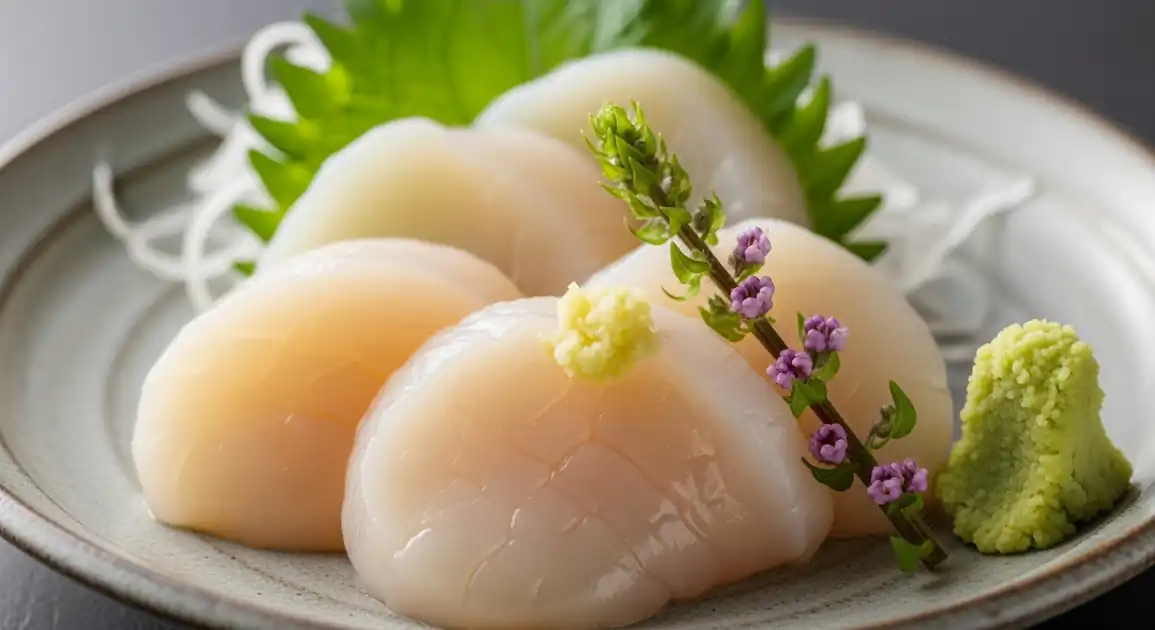Hotate (Scallops)
帆立 (Hotate)

Description
Hotate (scallops) are enjoyed throughout Japan, but Hokkaido is particularly renowned for producing the largest and sweetest varieties due to its cold waters. You can find high-quality Hotate in seafood markets, sushi restaurants, and izakayas nationwide, prepared in diverse ways from delicate sashimi to hearty grilled dishes.
Dietary Information
Serving information
Serving style
Served raw (sashimi/sushi) with soy sauce and wasabi. Grilled versions often come on the half-shell or skewers. Fried versions ('furai') served with sauces like tonkatsu sauce or tartar sauce. Served hot or cold depending on preparation.
Quick facts
Sushi/Restaurants: Lunch (11 AM - 3 PM), Dinner (5 PM - 11 PM). Markets: Early morning until early afternoon. Izakayas: 5 PM - Late.
Safety Tips
What to Look For
-
Reputable source (sushi restaurant, established market vendor, quality restaurant)
Essential for raw consumption. Reputable places adhere to strict hygiene and freshness standards.
-
Fresh appearance (plump, translucent/creamy white, firm)
Visual cues are key indicators of freshness for raw scallops. Avoid dull, discolored, or limp scallops.
-
Clean, sweet smell (slightly briny)
Fresh scallops should smell pleasant. Any off-putting odor (ammonia, strong fishiness) is a major red flag.
-
Proper refrigeration / Cooked to order
Raw scallops must be kept consistently cold. Cooked scallops should be prepared fresh upon ordering.
-
Clean handling practices by staff/vendors
Observe how seafood is handled, looking for clean surfaces, utensils, and handwashing/glove use.
What to avoid
-
Strong fishy, sour, or ammonia-like odor
Indicates spoilage. Do not consume.
-
Dull, discolored (greyish/yellowish), or slimy appearance
Signs that the scallop is not fresh and potentially unsafe, especially for raw consumption.
-
Scallops stored at improper temperatures (e.g., sitting out unrefrigerated)
Increases risk of bacterial growth significantly.
-
Unreputable or dubious sources (e.g., questionable street stalls with poor hygiene)
Higher risk of consuming improperly handled or unfresh seafood.
-
Pre-cut sashimi sitting uncovered for extended periods
Increases exposure to contamination and temperature fluctuations.
Price information
Price range
Budget tips
- Prices vary hugely by preparation and venue. Market stalls often offer grilled hotate for a few hundred yen.
- Sushi restaurants charge per piece (nigiri) or plate (sashimi), ranging from ~300-800 JPY per piece/small plate depending on quality.
- Izakaya prices for grilled hotate are typically moderate.
- Full seafood meals featuring hotate will be more expensive.
Value indicators
- Large, plump adductor muscle.
- Noticeable sweetness and clean flavor.
- Firm yet tender texture.
- Sourced from reputable regions like Hokkaido or Aomori.
Where to Find This Dish
Major Seafood Markets
Places like Tokyo's former Tsukiji Outer Market (now Toyosu related stalls) or regional markets offer fresh hotate.
Toyosu Fish Market (Tokyo), Local fish markets nationwide
Morning (market hours)
Sushi Restaurant Hubs
Areas known for concentrations of sushi restaurants (e.g., Ginza in Tokyo, downtown areas of major cities).
Restaurant districts, Department store food halls
Lunch, Dinner
Izakaya Alleys/Districts
Areas with many traditional pubs often feature grilled hotate.
Shinjuku Omoide Yokocho (Tokyo), Local 'yokocho' (alleys)
Evening (5 PM onwards)
Vendor Tips
- Look for signs indicating 'Hokkaido Hotate' (北海道産帆立) for reputed quality.
- For raw, choose places that look busy and clean, indicating high turnover.
- Don't hesitate to ask for recommendations ('osusume') from the staff.
How to Order
Regional Variations
-
Hotate Sashimi
(帆立刺身)
Thick slices of raw scallop, served plain or with soy sauce and wasabi.
-
Hotate Nigiri Sushi
(帆立握り寿司)
Slice of raw scallop served atop a small mound of vinegared sushi rice.
-
Yaki Hotate
(焼き帆立)
Grilled scallops, often served on the half-shell. Can be simply salted ('shioyaki') or flavored.
-
Hotate Butter Shoyu Yaki
(帆立バター醤油焼き)
Scallops grilled or pan-fried with butter and soy sauce, a popular and flavorful combination.
-
Hotate Furai (Fry)
(帆立フライ)
Scallops breaded with panko crumbs and deep-fried until golden brown and crispy.
-
Hotate in Kaisendon/Chirashi
(海鮮丼/ちらし寿司の帆立)
Raw scallop slices included as a topping on bowls of rice with assorted seafood.
Cultural context
History
Scallops have been consumed in Japan for centuries. Hokkaido, with its cold, nutrient-rich waters, became the epicenter for high-quality Hotate, both wild-caught and through advanced aquaculture techniques developed significantly in the 20th century. Hotate farming, especially suspension culture, allows for sustainable production of large, high-quality scallops, making them a widely available yet highly regarded seafood item across Japan and internationally.
Local significance
Hotate represents premium Japanese seafood, appreciated for its natural sweetness and texture. Hokkaido Hotate carries particular prestige.
Eating customs
- Sashimi/sushi eaten with chopsticks, dipped lightly in soy sauce (often with wasabi mixed in or applied directly to the fish).
- Grilled hotate often eaten directly from the shell or skewer.